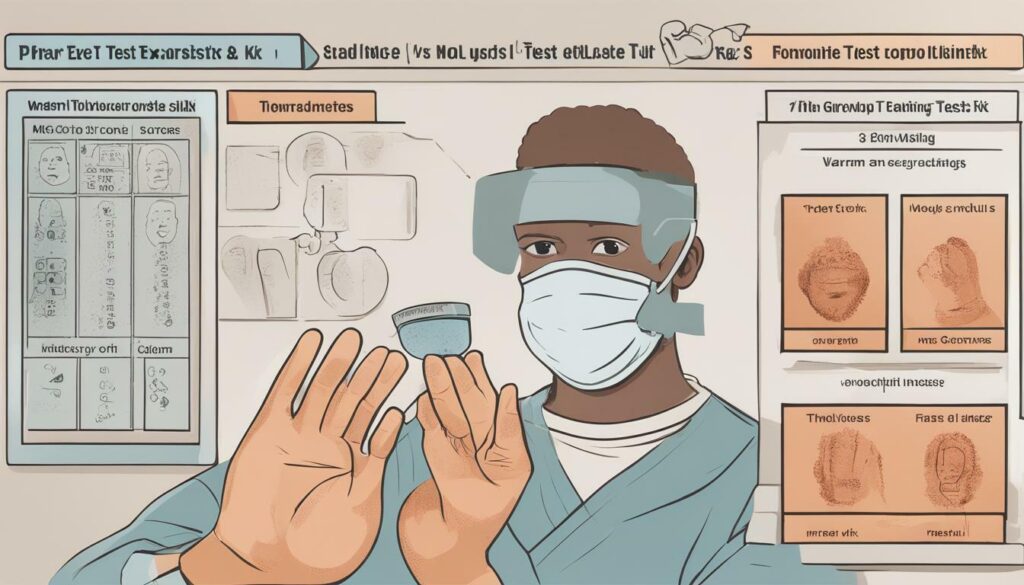If you suspect that you may have been exposed to mold, you may be wondering if there is a way to test yourself for mold exposure in the comfort of your own home. The good news is that there are at-home testing kits available that allow you to do just that. These kits use various methods to analyze samples taken from your home or workplace to determine if mold is present.
However, it’s important to understand the limitations of these tests and the proper usage to ensure accurate results. In this section, we will explore the possibility of testing yourself for mold exposure and the availability of at-home testing kits. We will discuss the benefits and limitations of these tests and provide guidance on their proper usage.
Key Takeaways:
- There are at-home testing kits available for individuals to test themselves for mold exposure.
- It is important to understand the limitations of these tests before using them.
- Proper usage of at-home testing kits can ensure accurate results.
Mold Exposure Testing Methods: Exploring DIY Options
If you suspect that you may have mold in your home, you may be wondering if it’s possible to test for mold exposure yourself. Fortunately, there are a variety of at-home mold exposure tests available that can help you determine if you have a mold problem.
DIY mold exposure tests are designed to detect the presence of mold in different areas of your home, including the air, surfaces, and materials. These tests come in different forms, including swab tests, tape tests, and air quality tests. Each test is designed to detect different types of mold and provide various levels of accuracy.
Swab Tests
Swab tests involve rubbing a swab on a surface in your home and then sending it to a lab for analysis. This test is useful for identifying visible mold growth and can provide insight into the type of mold present. However, it may miss mold that is not visible on the surface being tested.
Tape Tests
Tape tests involve applying clear tape to a surface with suspected mold growth and then examining the tape under a microscope. This test is useful for identifying the type of mold present but may not be as accurate as other tests in detecting low levels of mold.
Air Quality Tests
Air quality tests involve collecting air samples from your home and sending them to a lab for analysis. This test can detect the presence of mold spores in the air but may not be as accurate in identifying the source of the mold.
Keep in mind that DIY mold exposure tests have limitations and may not be as accurate as professional testing. Additionally, false negatives or positives can occur, and proper sample collection is essential for accurate results. If you suspect that you have mold in your home, it’s important to consider consulting with a professional to ensure that your home is safe and healthy for you and your family.
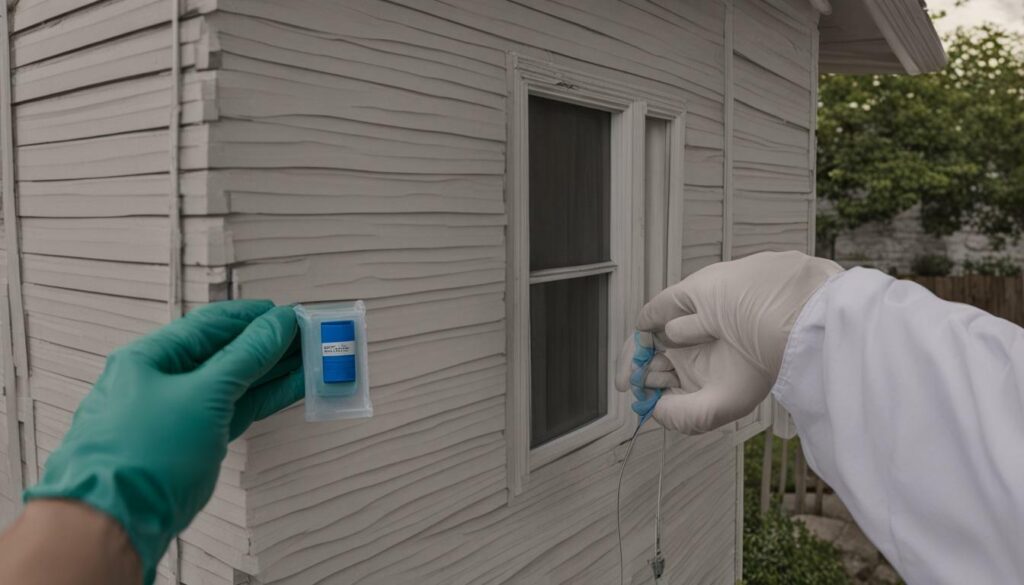

However, if you decide to use an at-home mold exposure test, be sure to follow the instructions carefully and choose the appropriate test for your needs. By taking proactive steps to detect and address mold in your home, you can help ensure a healthy living environment for you and your loved ones.
Understanding Mold Exposure Symptoms: Self-Assessment
If you suspect you’ve been exposed to mold, it’s important to understand the symptoms associated with mold exposure. By recognizing these symptoms, you can evaluate your own risk and determine if at-home testing is necessary.
Common symptoms of mold exposure may include:
- Frequent coughing or sneezing
- Shortness of breath
- Wheezing
- Nasal congestion
- Itchy or watery eyes
- Skin irritation
- Headaches
- Fatigue
- Mood swings
It’s important to note that these symptoms can also be caused by other factors, such as allergies or respiratory infections. However, if you are experiencing multiple symptoms and suspect that mold exposure may be the culprit, it’s worth conducting a self-assessment.
A self-assessment can help you evaluate the likelihood of mold exposure based on your symptoms. Take note of when and where you experience symptoms, and if anyone else in your household is also experiencing similar symptoms.
Keep in mind that a self-assessment is not a substitute for professional testing or medical advice. If you are experiencing severe symptoms or are at high risk for mold exposure, it’s important to consult a healthcare professional.


Tip: If you are unsure whether your symptoms are related to mold exposure, consider keeping a symptom diary to track when and where symptoms occur. This information can be useful for evaluating your risk and determining if professional testing is necessary.
The Benefits of At-Home Mold Exposure Tests
If you suspect you have mold in your living environment, testing for mold exposure is essential for maintaining your health. At-home mold exposure tests are a convenient and cost-effective option that can help you detect mold in various environments, such as your home or workplace.
One of the significant benefits of at-home mold exposure tests is their convenience. These tests are simple and easy to use, and you can conduct them in the comfort of your own home, without the help of a professional.
In addition to being convenient, at-home mold exposure tests are also cost-effective. Hiring a professional to test for mold exposure can be expensive. At-home testing kits provide a more affordable option that is accessible to everyone.
At-home mold exposure tests can detect mold in various environments. They can help you identify mold in the air, on surfaces, and in hidden areas such as within walls and under flooring. By detecting mold early, you can take immediate action to prevent further exposure and protect your health.
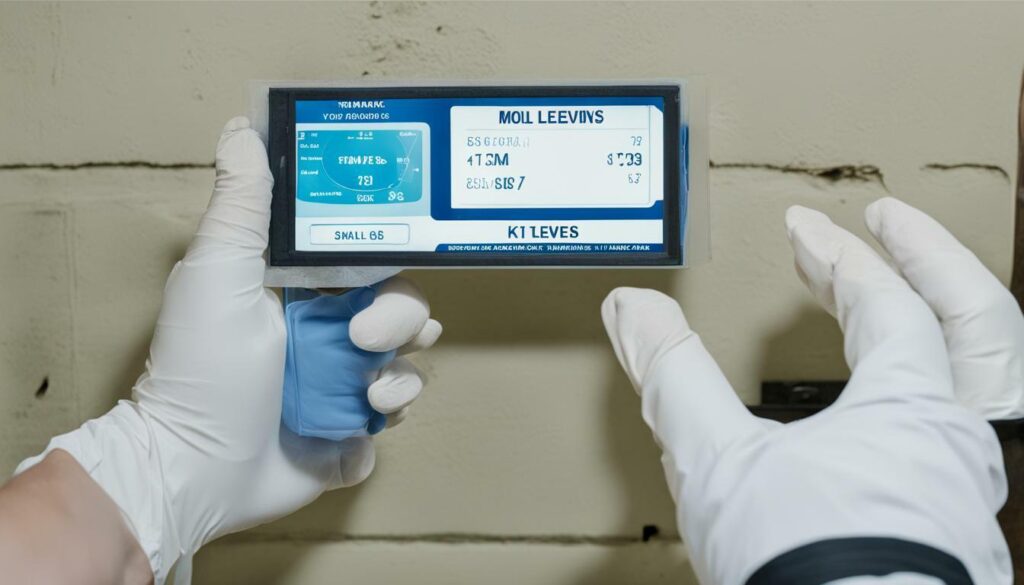

It is important to note that while at-home mold exposure tests can be beneficial, they do have limitations. For example, the accuracy of the test results can be affected by factors such as sample collection techniques, and false negatives or positives are possible. Understanding these limitations and following proper usage guidelines is critical for obtaining accurate results from your at-home mold exposure test.
Overall, at-home mold exposure tests provide a convenient and cost-effective way of detecting mold exposure in your living or work environment. By understanding the benefits of at-home testing, you can take proactive steps towards maintaining a healthier living environment.
Limitations of At-Home Mold Exposure Tests
While at-home mold exposure tests can be a convenient and cost-effective option, it is important to understand their limitations to ensure accurate results. One limitation to keep in mind is the potential for false negatives or positives. This can be due to factors such as improper sample collection techniques, environmental factors, and the sensitivity of the test itself.
Additionally, at-home tests may not be able to detect all types of mold or accurately determine the severity of an infestation. This is because certain types of mold are more difficult to detect and require specialized equipment or expertise.
It is important to approach at-home mold exposure tests with caution and be aware of their limitations. If you suspect a significant mold infestation or have concerns about your health, it may be necessary to seek professional assistance.


How to Use At-Home Mold Exposure Tests Effectively
If you have chosen to use an at-home mold exposure test, it is crucial to use it effectively to ensure accurate results. Follow these steps to maximize the effectiveness of your test:
- Read the instructions carefully: Before you begin, read the test instructions thoroughly. Make sure you understand each step and that you have all the necessary materials.
- Choose the right location: Select an area in your home where you suspect mold growth or where you experience symptoms of mold exposure. Make sure the area is clean and dry before taking the sample.
- Collect the sample: Use the sampling tool provided with the test kit to collect the air or surface sample. Follow the instructions carefully to ensure that you collect the appropriate sample size and that you do not contaminate the sample.
- Seal and send the sample: Once you have collected the sample, seal it in the provided container or bag and send it to the laboratory as instructed. Make sure you label the sample correctly to avoid confusion.
- Interpret the results: When you receive the results, read the report carefully and follow the instructions provided to understand the findings. If you have any questions or concerns, contact the laboratory or the test kit manufacturer for clarification.
Remember, at-home mold exposure tests have limitations, and their results may not always be accurate. It is important to use these tests as a screening tool and to consult a professional if you suspect a mold problem or experience symptoms of mold exposure.
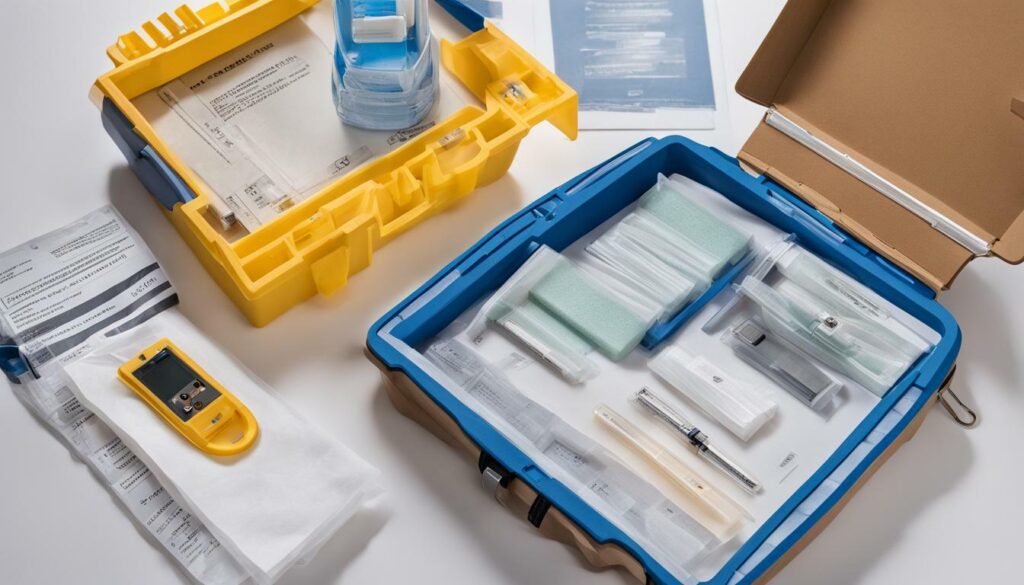

Tip: To ensure the accuracy of your at-home mold exposure test, avoid collecting the sample in areas with high airflow or areas near open windows or doors.
When to Consult a Professional for Mold Exposure Testing
While at-home mold exposure tests can provide a convenient and cost-effective way to assess your risk of mold exposure, there are situations where it is necessary to consult a professional for mold exposure testing.
If you suspect that your symptoms are related to mold exposure but your at-home test results are negative, it is important to seek medical advice and consider a professional inspection. Additionally, if you have a history of mold exposure or live in an area with high humidity levels, it is recommended to have your home tested by a professional to ensure a thorough assessment.
Keep in mind that self-diagnosis and at-home testing methods have their limitations, and professional testing and remediation may be required to effectively address mold exposure.


Professional mold tests can provide a more accurate assessment of mold levels and identify the specific type of mold present in your environment. Certified professionals have the necessary experience and equipment to properly collect and analyze samples, and can provide recommendations for remediation if necessary.
By understanding the boundaries of self-diagnosis and at-home testing methods, you can prioritize your health and ensure a more comprehensive assessment of mold exposure in your living environment.
Seeking Medical Advice for Mold Exposure Symptoms
Remember, it is always important to prioritize your health when it comes to mold exposure. If you have self-assessed and believe you may be experiencing symptoms related to mold exposure, it is crucial to seek medical advice. A healthcare professional can help diagnose the extent of exposure and advise on the necessary next steps.
Ignoring symptoms or self-diagnosing can lead to prolonged exposure, which can cause serious health risks such as respiratory issues, allergies, and other related symptoms. While self-assessment can provide initial insight, only a qualified medical professional can provide an accurate diagnosis.
Don’t hesitate to seek assistance if you believe you may be at risk for mold exposure. A quick visit to a healthcare professional can help you take necessary steps to protect yourself and your loved ones from the potential health risks associated with mold exposure. Remember to always prioritize your health!
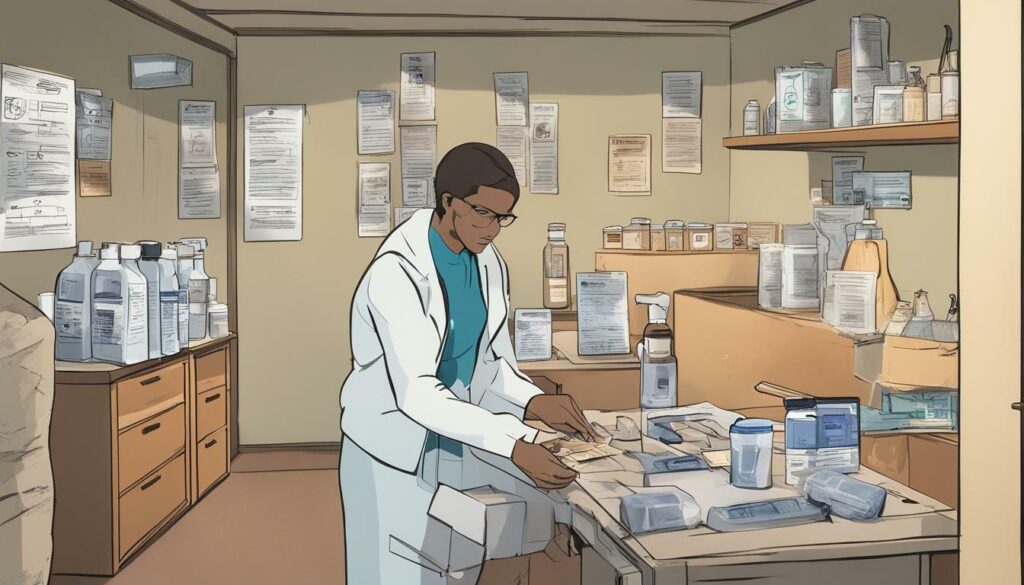

Tips for Preventing Mold Exposure
To reduce your risk of mold exposure, there are several preventative measures you can take:
- Keep humidity levels in your home below 60% by using air conditioning and dehumidifiers.
- Ensure proper ventilation in bathrooms, kitchens, and other areas that produce moisture.
- Regularly clean and inspect areas prone to mold growth, such as basements, attics, and crawl spaces.
- Use mold-resistant products, such as drywall and paints, in areas of high moisture and humidity.
- Fix any leaks or plumbing issues promptly.
- Remove any excess water and dry any wet areas within 24-48 hours.
By implementing these prevention strategies, you can minimize your risk of mold exposure. However, if you do notice any mold growth or experience symptoms of mold exposure, it’s important to take action immediately.


Remember, prevention is key in staying mold-free and maintaining a healthy living environment.
Understanding the Importance of Mold Exposure Awareness
Mold exposure can have serious health implications, including respiratory issues, allergies, and other symptoms. That is why it is important to be aware of the risks of mold exposure and understand how to prevent it.
Prevention is key when it comes to mold exposure. Taking steps to maintain a clean and dry environment is essential. Keep your home well-ventilated, fix any leaks or water damage, and regularly clean surfaces that are prone to mold growth. By implementing these preventative measures, you can reduce your risk of mold exposure.
Additionally, it is important to be aware of the symptoms of mold exposure and know how to conduct an at-home mold exposure test. By recognizing the signs and taking proactive steps towards a healthier living environment, you can protect yourself and your loved ones from the potential health risks associated with mold exposure.


Remember, prevention is the best defense against mold exposure. Stay informed, take action, and prioritize your health and well-being.
Conclusion
In conclusion, if you suspect that you may have been exposed to mold, it is important to take action and consider testing for mold exposure. At-home testing kits can provide a convenient and cost-effective option for individuals to test themselves for mold exposure, but it is important to understand their limitations. Remember to also self-assess your symptoms and seek medical advice if necessary.
Preventative measures, such as proper ventilation, humidity control, and regular cleaning practices, can also help to reduce the risk of mold exposure. By creating awareness about the risks and taking proactive steps towards a healthier living environment, you can protect yourself and your loved ones from potential health implications related to mold exposure.
Remember:
Can I test myself for mold exposure? Yes, but it is important to be aware of the limitations of at-home testing kits. Prioritize your health and consult a healthcare professional if you have concerns about mold exposure symptoms. Take preventive measures to create a mold-free living environment and stay aware of the potential risks associated with mold exposure.
FAQ
Q: Can I test myself for mold exposure?
A: Yes, you can test yourself for mold exposure using at-home testing kits.
Q: What are the different methods available for testing mold exposure at home?
A: There are various types of tests available, including air sampling, surface sampling, and tape lift sampling.
Q: How can I assess my own symptoms for mold exposure?
A: You can evaluate your symptoms through a self-assessment framework to determine the likelihood of mold exposure.
Q: What are the benefits of using at-home mold exposure tests?
A: At-home tests offer convenience, cost-effectiveness, and the ability to detect mold in various environments.
Q: What are the limitations of at-home mold exposure tests?
A: Factors like sample collection techniques and potential false negatives or positives may affect the accuracy of these tests.
Q: How can I use at-home mold exposure tests effectively?
A: Follow the step-by-step guide provided with the test kit, including proper sample collection and result interpretation.
Q: When should I consult a professional for mold exposure testing?
A: It is necessary to consult a professional when at-home tests may not be sufficient or when professional assessment and remediation are required.
Q: When should I seek medical advice for mold exposure symptoms?
A: It is important to seek medical advice if you experience symptoms related to mold exposure, as prolonged exposure can have health risks.
Q: What are some tips for preventing mold exposure?
A: Maintain a mold-free environment by ensuring proper ventilation, controlling humidity, and practicing regular cleaning.
Q: Why is mold exposure awareness important?
A: Mold exposure can lead to respiratory issues, allergies, and other symptoms, so creating awareness is essential for a healthier living environment.

